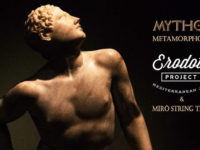Bob Salmieri is an Italian composer, multi-instrumentalist and writer. He is also established as one of Europe’s foremost musicians, not just because of his playing but also due to the ongoing presence on the scene of the label he co-runs, Cultural Bridge.
His projects include Herodotus, Milagro and the Bastarduna Quintet, which brings on board trumpet player Giancarlo Romani, bass player Maurizio Perrone, drummer Massimiliano De Lucia and Vincenzo Lucarelli on organ and Rhodes piano, with guest Mateusz Nawrot on vibraphone on one track of And Mama Was a Belly Dancer and grand piano on two.
This new album was made between October and December 2020, in a slightly eclectic manner, due to the vagaries which went with the COVID-19 restrictions. And Mama Was a Belly Dancer is a concept album, partly autobiographical and also includes fantastical characters. Both the journey of life and the characters are seen through the eyes of a child. This record is inspired by the events told in a book authored by Salmieri, which is forthcoming. And Mama Was a Belly Dancer is on digital platforms and physical form, with distribution by CD Baby. The liner notes are by Adam Baruch, who argues And Mama Was a Belly Dancer proves that even in a pandemic music heals and keeps us sane.
Bastarduna means the second flowering of Opuntia triacantha (the prickly pear cactus) but it also means the opportunity of a second chance, which perhaps is what this music has captured.
Bob Salmieri explores childhood memories, some with a passing glance, while others go deeper: a child seeking answers and searching for them using the medium of music. The tracks include some coherent melodic themes, full of romance, lyricism and reflection and also a touch of blues, and there is energy which flows across this album.
The opening title track from And Mama Was a Belly Dancer is announced with a sax that heralds the powerful mix of melodic phrasing over steady rhythms of a bluesy nature. The rhythm change from 7 to 8 beats is a beautiful intertwining of Eastern and Western vibes. This track is intriguing, engaging and powerful, from the sultry opener of Salmieri’s sax, to the drop-by-drop entry of the drums, organ and trumpet.
Each adds their own voice to the picture embodied in the title of a dancer weaving her way amongst the crowd perhaps, or stepping lightly over reclining bodies, her robes flowing and colorful. The second half has more of an Eastern essence than the first and, as so often with Salmieri, there is that mix of cultures he transits so well.
“The Balinese Dancer” is light, fanciful and the melody established by Mateusz Nawrot’s vibraphone initially, before it is joined by percussion and the theme is later picked up by Bob Salmieri’s sax which adds depth and texture. The infusion of light and dark is wonderfully explored, with the gentle melody continuing under the increasingly improvisational sax. At the change in rhythm, Giancarlo Romani’s trumpet adds its voice and a solo which, as one might expect from the class that is Romani, is superb and timely.
“Madame Oculus” is opened by a bass note before a brassy, loud wall of sound from Salmieri’s sax and trumpet develops, linked to a delicate piano line which offers a gentler presence. The trumpet delivers a superb solo across the top of solid support. The off-beat response-and-call section is engaging, and the piano proffers again a gentler interlude – this time picked up by the sax. “Madame Oculus” proves herself quite a surprise.
“The Flying Devils” feels like a visit to your grandpa: All chordal, vibraphone, keys and soft brass, which feels like it wants to say more but is wary of doing so. Lucarelli’s Rhodes lifts this track and enhances the theme, which the horns comply with and Romani’s trumpet sails away with. The percussion drives the second half with intricate off-kilter beats and picks before Salmieri’s sax, breathy and loose embouchured, adds its own well-developed solo. The final section is piano led as the gentle but firm presence re-asserts itself and harmony rules.
“Mr. Thunder” stars with fugal entry of the brass which eventually works into a darub pattern into which the trumpet drops, emphasizing the pauses so important to the Eastern feel. However, this is set up to be dismantled as the piano interjects a short transition section before Salmieri’s sax enters huskily and drives the rhythm toward a bluesy beat. Eastern music often makes for an easy passage, as the rhythms have similarities. Giancarlo Romani’s punchy trumpet line adds a playfulness, while the support from bass and percussion is steady. The final section is harmonious and “Mr. Thunder” is not angry after all.
“The Dwarf’s Lover” has a sense of playful frivolity and fairground imagery, enhanced by Vincenzo Lucarelli’s organ solo from Lucarelli. Neatly superseded by the sax and trumpet, the organ again reasserts itself before Bob Salmieri’s sax lifts out across the top. The trumpet wafts in jazz style, before a brief reprise from the organ and finally the ensemble finish the track together in harmony.
“The Balinese Dancer (Reprise)” is again gentle and melodic, the repeating melody like a memory which resurfaces in the imagination. Romani’s trumpet explores around the theme and changes the rhythm into a blues with piano punctuating, and echoing the short phrases but the intrinsic melody remains.
“Men With the Painted Faces” is fun, playful and artfully uses off-set rhythms to create episodes which contrast and yet meld together. The trumpet delivers a glorious free flowing solo, as does Salmieri’s sax and the track makes for a great finish to And Mama Was a Belly Dancer.
Bob Salmieri blends Eastern and Western rhythmic patterns seamlessly, and in this music there is a bluesy overtone which pervades too. In the Mediterranean culture, music styles like Rebetiko – the urban Greek music which brings together many influences – and Arabic music, with its rhythmic patterns lead easily with just the addition of grace notes or the leaning on the middle beat, to a bluesy feel. Salmieri understands this.
The change of instrumentation, especially the addition of organ, trumpet and vibraphone serve to create what Bob Salmieri terms Mediterranean jazz. It is appealing and incisive, tapping into connections felt by many people with many cultures. A great listen.
- Milena Casado – ‘Reflection of Another Self’ (2025) - May 4, 2025
- Luis Ianes and Noel Akchote – ‘Seuil’ (2025) - April 12, 2025
- David Dower Trio – ‘Sonder’ (2025) - March 23, 2025




